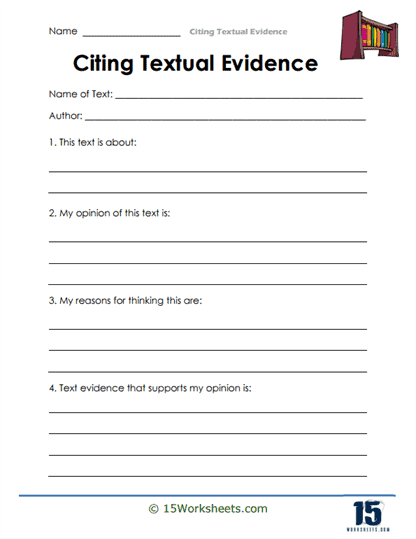

Effectively incorporating textual evidence is a fundamental skill for students engaged in analytical writing. This series of 15 worksheets have been thoughtfully designed to guide students through the process of citing textual evidence accurately and integrating it seamlessly into their writing. Each worksheet focuses on a specific aspect of citing evidence, providing clear examples and practice exercises to reinforce students’ understanding.
These worksheets cover various aspects of citing textual evidence, including quoting, paraphrasing, and citing sources. Students will learn how to select relevant evidence, properly attribute it to the source, and effectively integrate it into their own writing. By engaging with these worksheets, students will develop the necessary skills to support their arguments, analyze texts critically, and enhance their overall writing proficiency. Through these worksheets, students will:
By engaging with these Citing Textual Evidence worksheets, students will develop the necessary skills to incorporate textual evidence seamlessly into their analytical writing. Through practice exercises and clear examples, they will gain confidence in selecting relevant evidence, attributing it correctly, and analyzing its significance within their arguments. Overall, these worksheets provide a solid foundation for students to strengthen their analytical writing skills and communicate their ideas effectively using evidence from the text.
Textual writers need to provide references to back up their arguments. When you quote from a text to back up your claims, this is called citing evidence. You can either use direct quotations from the book or rephrase the material. To directly quote means to use the exact words from the original text in your writing. Writers must always use quotation marks around a direct quote to indicate that they are paraphrasing the precise words of another author.
Why is it Necessary to Have Textual Evidence?
Visualizing textual evidence as supporting the author’s argument is helpful. Without supporting evidence, any reader can disprove the author’s assertion. Contrary to addressing a math issue, textual analysis is more of an art than a science. You can nearly always find alternative interpretations or analyses that work well.
For instance, a brief story can leave one reader feeling down while others feeling encouraged. Both readers’ interpretations of the short story would be valid if they could back up their claims with textual proof.
Finding the most convincing argument is the obstacle to overcome. Textual analysis and presenting textual evidence in support of ideas are analogous to the method. The textual proof must be pertinent to the writer’s assertion and explicit enough to be unrefuted.
There is a process involved in providing references to texts:
Important Considerations
When picking a chapter to teach this skill, keep these three things in mind:
1. Pick a Simple Reading
When introducing your students to locating text evidence, you should start with a bit of a nonfiction passage. It needs to be easy to read. Students won’t read the passage if they find it challenging and frustrating. Also, they won’t be acquiring these crucial capabilities.
2. Promote Achievement and Self-Assurance
Another reason to keep the reading short and simple is that students need to gain experience and confidence with this new talent. You also want your students to put more effort into finding and labeling the answers in the passage than understanding the text’s meaning.
3. Seek Readings with Questions that Hinge on the Text
Any questions you answer from the reading selection should be based on what is mentioned in the text. It’s great to ask inferential questions, but it’s not the best way to teach students how to detect textual evidence properly.
When answering questions about a reading passage, students must go back to the text to hunt for, recognize, and highlight relevant passages that provide that proof. Students will become frustrated if the proof is not presented explicitly. However, after they have a firmer grasp of the idea, they can go on to the more complex lesson you mentioned.
4. Choose the Appropriate Citation Style
The citation style you use depends on the requirements of your assignment or the publication you are submitting your paper to. Common citation styles include APA, MLA, Chicago, and Harvard. Follow the citation style guidelines for formatting the evidence. This may include including the author’s name and page number for direct quotes or providing the author’s name and date for paraphrases or summaries.
Here is an example of a citation for a direct quote using the APA citation style:
According to Smith (2019), “Textual evidence is an important aspect of academic writing” (p. 45).
And here is an example of a citation for a paraphrase using the MLA citation style:
Smith argues that citing textual evidence is a crucial part of academic writing (45).